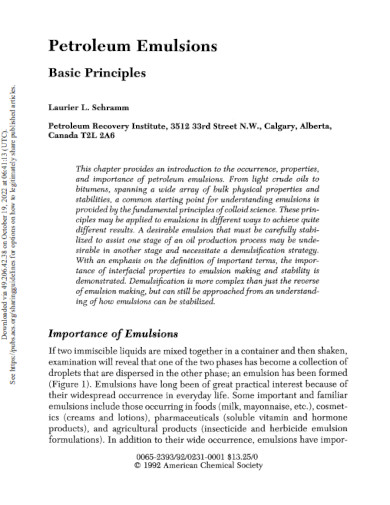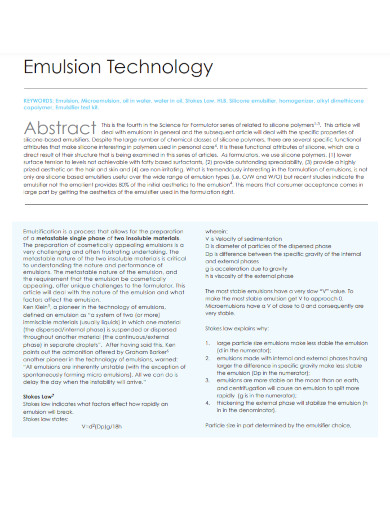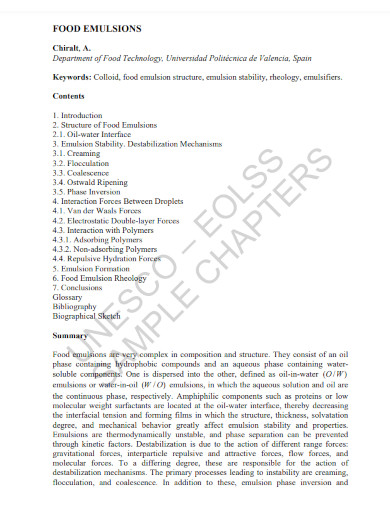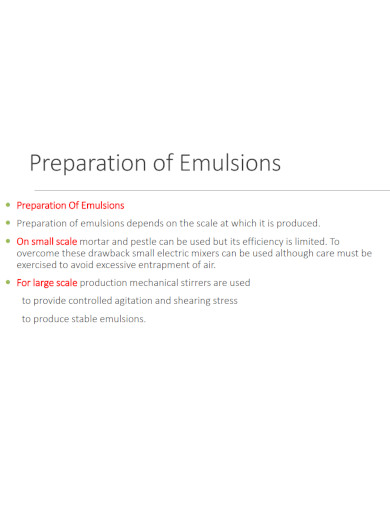What is a carbon emulsion?
A type of solid carbon
A mixture of carbon particles in a liquid
A gas form of carbon
A pure carbon compound

Many foods we eat are emulsions like ice cream, margarine, and milk. Not only are emulsions used for food, but we also use these products, services, and commodities that utilize emulsions in different contexts like petroleum gels, silicone, and vanishing cream.
An emulsion is a type of mixture that is outlined by its immiscible ingredients, which are a product of two or more elements that have different surface tension. If you want to learn more about emulsions you may read up on any of the articles on how to dispense emulsion, the relationship between emulsions and technology, the stability of the emulsion, and how to prepare emulsions.
Like all compounds, it is very important to be able to distinguish between emulsions and other types of combinations. Knowing whether the mixture is an emulsion or a solution, allows us to understand whether people can separate the ingredients via different methods and means.
An emulsion is usually formed by two or more ingredients with chemical properties and physical properties that are liquid in form. This means that you must check whether the ingredients used in the emulsion are in liquid form. Note this does not mean that the emulsion is going to be fully in liquid form, as the ice cream is an emulsion that is consumed in its solid state.
Most emulsions will have their ingredients in a way that is hard to separate. Check and determine whether it is possible to separate the ingredients.
People create emulsions from two or more immiscible ingredients. This means that the ingredients cannot mix, so if the mixture has two ingredients that do not mix then it can be considered an emulsion.
In an emulsion, when a person shines a light through it, a cloudy textured liquid is seen. You must shine a light through the mixture to check whether said light is dispersed through a cloudy liquid.
Scientists and chemists base the types of emulsions on their mixture or particle size. The two types of emulsion based on the mix of water and oil are oil-in-water emulsion (O/W) and water-in-oil emulsion (W/O). A macro-emulsion is a type of emulsion where the droplets of the mixture are above 10mm. Mini-emulsion is a type of emulsion where the droplets are at the in-between of 0.1 – 10µm. Micro-emulsion, on the other hand, has droplets in-between 100-600nm. Lastly, a nanoemulsion is an emulsion whose droplets are below 100nm.
There are plenty of factors that affect the rate of emulsion formation in a specific given mixture. These factors include the time of agitation, temperature, the ratio between the two ingredients, dispersion of the ingredients, the amount of mechanical energy used, and the presence or absence of impurities in the ingredients. When used and paced correctly, the chemist can guarantee the creation of the specific emulsion
Milk is a white, heterogeneous, opaque emulsion, colloid suspension, and solution comprising various ingredients. In actual solutions, lactose, certain minerals, soluble proteins, and proteins are present as an emulsion together with colloidal suspensions of fat. Milk also exemplifies the diverse dynamics that all emulsions exhibit.
The emulsion is a type of mixture that has two-or-more unmixable and insoluble liquid ingredients. A lot of modern-day combinations rely on the existence of emulsions. Modern examples of emulsions are ice creams, mayonnaise, and milk. Therefore one should know how to identify emulsions from other compounds or products.

Many foods we eat are emulsions like ice cream, margarine, and milk. Not only are emulsions used for food, but we also use these products, services, and commodities that utilize emulsions in different contexts like petroleum gels, silicone, and vanishing cream.

uomustansiriyah.edu.iq
Details
File Format
Size: 46 KB

pubs.acs.org
Details
File Format
Size: 52 KB

scientificspectator.com
Details
File Format
Size: 71 KB

svu.edu.eg
Details
File Format
Size: 28 KB

entegris.com
Details
File Format
Size: 80 KB
![]()
shinetsusilicone-global.com
Details
File Format
Size: 63 KB

eolss.net
Details
File Format
Size: 70 KB

acikders.ankara.edu.tr
Details
File Format
Size: 24 KB
An emulsion is a type of mixture that is outlined by its immiscible ingredients, which are a product of two or more elements that have different surface tension. If you want to learn more about emulsions you may read up on any of the articles on how to dispense emulsion, the relationship between emulsions and technology, the stability of the emulsion, and how to prepare emulsions.
Like all compounds, it is very important to be able to distinguish between emulsions and other types of combinations. Knowing whether the mixture is an emulsion or a solution, allows us to understand whether people can separate the ingredients via different methods and means.
An emulsion is usually formed by two or more ingredients with chemical properties and physical properties that are liquid in form. This means that you must check whether the ingredients used in the emulsion are in liquid form. Note this does not mean that the emulsion is going to be fully in liquid form, as the ice cream is an emulsion that is consumed in its solid state.
Most emulsions will have their ingredients in a way that is hard to separate. Check and determine whether it is possible to separate the ingredients.
People create emulsions from two or more immiscible ingredients. This means that the ingredients cannot mix, so if the mixture has two ingredients that do not mix then it can be considered an emulsion.
In an emulsion, when a person shines a light through it, a cloudy textured liquid is seen. You must shine a light through the mixture to check whether said light is dispersed through a cloudy liquid.
Scientists and chemists base the types of emulsions on their mixture or particle size. The two types of emulsion based on the mix of water and oil are oil-in-water emulsion (O/W) and water-in-oil emulsion (W/O). A macro-emulsion is a type of emulsion where the droplets of the mixture are above 10mm. Mini-emulsion is a type of emulsion where the droplets are at the in-between of 0.1 – 10µm. Micro-emulsion, on the other hand, has droplets in-between 100-600nm. Lastly, a nanoemulsion is an emulsion whose droplets are below 100nm.
There are plenty of factors that affect the rate of emulsion formation in a specific given mixture. These factors include the time of agitation, temperature, the ratio between the two ingredients, dispersion of the ingredients, the amount of mechanical energy used, and the presence or absence of impurities in the ingredients. When used and paced correctly, the chemist can guarantee the creation of the specific emulsion
Milk is a white, heterogeneous, opaque emulsion, colloid suspension, and solution comprising various ingredients. In actual solutions, lactose, certain minerals, soluble proteins, and proteins are present as an emulsion together with colloidal suspensions of fat. Milk also exemplifies the diverse dynamics that all emulsions exhibit.
The emulsion is a type of mixture that has two-or-more unmixable and insoluble liquid ingredients. A lot of modern-day combinations rely on the existence of emulsions. Modern examples of emulsions are ice creams, mayonnaise, and milk. Therefore one should know how to identify emulsions from other compounds or products.
Text prompt
Add Tone
10 Examples of Public speaking
20 Examples of Gas lighting
What is a carbon emulsion?
A type of solid carbon
A mixture of carbon particles in a liquid
A gas form of carbon
A pure carbon compound
Which of the following is a common use of carbon emulsion?
Fuel
Lubricant
Ink production
Explosives
What property of carbon emulsions makes them useful in photographic films?
High viscosity
Light sensitivity
High reactivity
Low density
Which type of carbon is commonly used in carbon emulsions for inks?
Diamond
Graphite
Carbon nanotubes
Fullerenes
What is the role of a surfactant in a carbon emulsion?
To increase viscosity
To stabilize the emulsion
To enhance color
To reduce density
In carbon emulsions, what does the term "dispersion" refer to?
The dissolution of carbon in a solvent
The spread of carbon particles throughout a liquid
The evaporation of the liquid medium
The reaction of carbon with oxygen
Which method is commonly used to produce carbon emulsions?
Electrolysis
Grinding and mixing
Chemical synthesis
Distillation
What is a key characteristic of a stable carbon emulsion?
Rapid settling of particles
Homogeneous distribution of particles
Large particle size
High evaporation rate
Which industry extensively uses carbon emulsions for their conductive properties?
Textile
Electronics
Food and beverage
Automotive
What is the primary challenge in creating a carbon emulsion?
Obtaining pure carbon
Ensuring uniform particle size
Achieving high viscosity
Maintaining low cost
Before you leave, take our quick quiz to enhance your learning!

